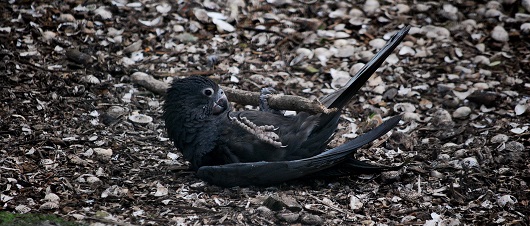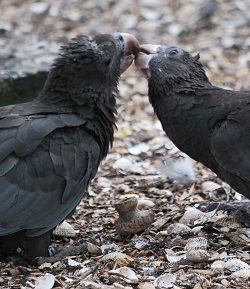“Goth” parrots join exclusive tool-using elite

Psychologists at the University of St Andrews have discovered previously unknown skills in parrots.
The Greater Vasa parrot, known as the “Goth” parrot for its black and grey sombre plumage, has been observed using, and sharing, grinding tools for the first time outside of humanity.
Researchers, led by psychologists at the University of York, studying ten captive parrots observed the birds adopt a novel tool-using technique to acquire calcium from seashells as well as active-sharing of tools among themselves.
The birds used small pebbles or date pits to grind calcium powder from the shells or to break off small pieces of shell to ingest. This behaviour, never before seen in this species, is the first evidence of a non-human using tools for grinding, and one of the few reports of non-human animals sharing tools directly.
Observing and filming the parrots over an eight month period (March to October), researchers documented their interactions with cockle shells on the floor of their aviary. Shells are a known source of calcium for birds.
Dr Amanda Seed, Lecturer in the School of Psychology and Neuroscience at the University of St Andrews, said: “These parrots are remarkable for many reasons: the females are the dominant sex, they cooperate to raise their young, and now we have found that, in captivity at least, they use pebbles as grinding tools. We hope to be able to work further with this fascinating species to find out more about their behaviour and cognition.”
Five out of ten birds were documented using tools, placing either pebbles or date pits inside shells to grind against the shell, or using them as a wedge to break apart the seashell.
Interest in the shells was greatest from March to mid-April, just before the breeding season – this may be due to calcium supplementation being critical for egg-laying. Researchers were initially surprised to find that it was the males, not the females, who showed the greatest interest in shells.
 However, observation of the parrots’ breeding behaviour showed that males often engaged in regurgitative feeding of females before copulating with them, thus potentially passing on the calcium benefits.
However, observation of the parrots’ breeding behaviour showed that males often engaged in regurgitative feeding of females before copulating with them, thus potentially passing on the calcium benefits.
Megan Lambert, PhD student in York’s Department of Psychology and lead author on the study, said: “The use of tools by nonhuman animals remains an exceedingly rare phenomenon. These observations provide new insights into the tool-using capabilities of parrots and give rise to further questions as to why this species uses tools.
“Tool use could reflect an innate predisposition in the parrots, or it could be the result of individual trial and error learning or some form of social learning. Whether these birds also use tools in the wild remains to be explored, but ultimately these observations highlight the Greater Vasa parrot as a species of interest for further studies of physical cognition.”
Notes to news editors
Issued by the University of St Andrews Communications Office, contactable on 01334 462530 or [email protected].
Category Research